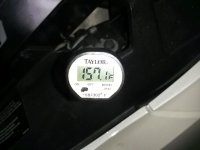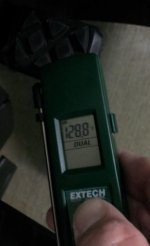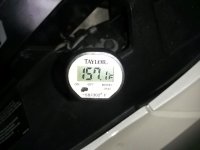It depends on your definition of "hot," or BRP Takes a Page from the Clinton Playbook
By way of status update, I now find that I have to prove to BRP--via my dealer--that what I am experiencing with purported, alleged, and X-Files-worthy Hot Right Foot Syndrome is something out of the ordinary and something that really should be covered under warranty or whatever. I get it and understand validation of problems, etc. I know that BRP has a vested financial and legal interest in weeding out the bogus claims, and both BRP and my dealer have reputations to uphold. No complaints really from me there. So I am going to take my Spyder ST to my dealer soon to have them ride it and experience the hot for themselves. This was the recommendation from BRP, from what I gather. Not sure why they checked the stock of panels when I called them if this was going to be a many-week process of proving beyond a shadow of a doubt...
What concerns me is that we are skidding into a Clintonesque ("depends on what definition of 'is' is) semantic tug of war where the very meaning of the word 'hot' gets analyzed and dissected. This is problematic for me (especially as a guy with multiple degrees in language--language is problematic at best), because when I complain of the house being hot, my wife is at the same time shivering and saying it's too cold. Words have no real meaning (or different meanings to different people), and all things experienced are subjective. Due to cooling temperatures outside, I would hate to have to deal with this situation through the winter and into next spring/summer to prove what hot really is--hot for me was in July when the underside of my seat was 150+ degrees according to my rather expensive IR thermometer and the side panels and foot peg areas were not much cooler. Hot was feeling as though Texas red ants were crawling in my jeans as I sat on the bike and feeling the sensation of immersing my foot in scalding hot water.
So I am starting to document my experiences here in early October every time I ride it to work so that when I take it in to the dealer I have hard, cold, factual data points. This morning, riding while still dark outside the 22 miles from Leesburg to Tysons Corner VA where I work, averaging around 50 miles per hour with only two red-light stops, the temperature outside was in the low 60s. When I got to work, I used the IR probe and found the brake pedal area and the paneling around it to be nearly 130 degrees (128.8 to be precise). I was wearing dressier boots (so thick quality leather, not thin dress shoes or low cut sneakers), but by the time I got to work my foot was feeling the heat, even in the cool prior to dawn.
So my questions are, and I would really appreciate your thoughts whether they substantiate or refute my own:
1. What is acceptable hot and what is unacceptable hot? At what temperature is the Spyder (or at least where my legs and feet are) getting too hot? I understand that all vehicles and motorcycles have hot parts, but on the many cruisers I have owned I never felt excessive heat unless I touched the exhaust pipe accidentally.
2. Are there design specs or regulatory specifications demanding temperatures within a certain range or set of parameters? Can any automotive or mechanical whizzes let me know if a real definition of "too hot" exists in this context? What does the industry consider too hot?
3. What are your readings and data points, and do they mesh with mine?
I want to deal with facts and hope that by sharing facts we substantiate this phenomenon while also helping BRP and the dealers weed out any attempts to game them with unsubstantiated claims. Thanks for your time!
THE TRUTH IS OUT THERE, FOX MULDER! [queue the spooky X-Files theme song...]
By way of status update, I now find that I have to prove to BRP--via my dealer--that what I am experiencing with purported, alleged, and X-Files-worthy Hot Right Foot Syndrome is something out of the ordinary and something that really should be covered under warranty or whatever. I get it and understand validation of problems, etc. I know that BRP has a vested financial and legal interest in weeding out the bogus claims, and both BRP and my dealer have reputations to uphold. No complaints really from me there. So I am going to take my Spyder ST to my dealer soon to have them ride it and experience the hot for themselves. This was the recommendation from BRP, from what I gather. Not sure why they checked the stock of panels when I called them if this was going to be a many-week process of proving beyond a shadow of a doubt...
What concerns me is that we are skidding into a Clintonesque ("depends on what definition of 'is' is) semantic tug of war where the very meaning of the word 'hot' gets analyzed and dissected. This is problematic for me (especially as a guy with multiple degrees in language--language is problematic at best), because when I complain of the house being hot, my wife is at the same time shivering and saying it's too cold. Words have no real meaning (or different meanings to different people), and all things experienced are subjective. Due to cooling temperatures outside, I would hate to have to deal with this situation through the winter and into next spring/summer to prove what hot really is--hot for me was in July when the underside of my seat was 150+ degrees according to my rather expensive IR thermometer and the side panels and foot peg areas were not much cooler. Hot was feeling as though Texas red ants were crawling in my jeans as I sat on the bike and feeling the sensation of immersing my foot in scalding hot water.
So I am starting to document my experiences here in early October every time I ride it to work so that when I take it in to the dealer I have hard, cold, factual data points. This morning, riding while still dark outside the 22 miles from Leesburg to Tysons Corner VA where I work, averaging around 50 miles per hour with only two red-light stops, the temperature outside was in the low 60s. When I got to work, I used the IR probe and found the brake pedal area and the paneling around it to be nearly 130 degrees (128.8 to be precise). I was wearing dressier boots (so thick quality leather, not thin dress shoes or low cut sneakers), but by the time I got to work my foot was feeling the heat, even in the cool prior to dawn.
So my questions are, and I would really appreciate your thoughts whether they substantiate or refute my own:
1. What is acceptable hot and what is unacceptable hot? At what temperature is the Spyder (or at least where my legs and feet are) getting too hot? I understand that all vehicles and motorcycles have hot parts, but on the many cruisers I have owned I never felt excessive heat unless I touched the exhaust pipe accidentally.
2. Are there design specs or regulatory specifications demanding temperatures within a certain range or set of parameters? Can any automotive or mechanical whizzes let me know if a real definition of "too hot" exists in this context? What does the industry consider too hot?
3. What are your readings and data points, and do they mesh with mine?
I want to deal with facts and hope that by sharing facts we substantiate this phenomenon while also helping BRP and the dealers weed out any attempts to game them with unsubstantiated claims. Thanks for your time!
THE TRUTH IS OUT THERE, FOX MULDER! [queue the spooky X-Files theme song...]
Last edited:



